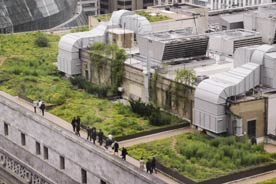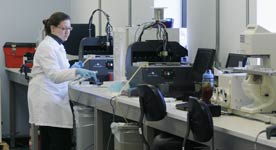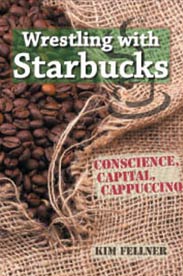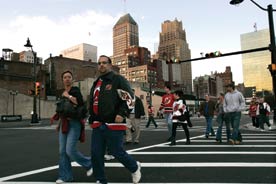
Mayor Richard M. Daley leads a tour of Chicago City Hall’s rooftop garden. Completed in 2001, the rooftop garden is an urban green-building experiment to test heating and cooling benefits.
As the United States enters a period of rapid growth that will have a profound effect on our national wellbeing, the next president will face an unprecedented challenge. He will also have an unprecedented opportunity to help states, cities, and towns shape communities to maximize our quality of life while conserving environmental and economic resources.
By 2030 we will have a population increase of 70 million, and we can expect 40 million new jobs compared to the 2005 level. We will also experience an amazing expansion of our built environment: 50 million new and replacement homes and 78 billion square feet of offices, shops, schools, and other nonresidential space, along with potentially massive amounts of transportation and municipal infrastructure required to serve it.
We have never faced this amount of growth before in so short a time. How we respond will determine whether we can maintain an equitable and prosperous society, and whether we can secure a healthy environmental future for our children and grandchildren.
We cannot allow growth to occur in the same way we did in the second half of the 20th century. Suburban sprawl has forced citizens and businesses alike to drive ever-longer distances. At the same time, because of chaotic, wasteful development patterns, meaningful alternatives have become unavailable for most Americans.
The results include astounding growth in greenhouse gas emissions from increased automobile use, excessive energy use, air and water pollution, tragic consumption of natural ecosystems and farmland, traffic congestion, economic waste, and a range of serious social problems, particularly for urban populations left behind. Transportation is now second only to housing in claiming over 20 percent of an average household’s budget, and over 40 percent of the average budget for those of lower income. These numbers are only going up with rising energy prices. At the same time, buildings and the transportation system required to serve them already emit 60 percent of our increasing global warming emissions.
The good news is that we can avoid a national crisis if we shape this growth efficiently and equitably. If we do not, the strain on our country will be immense. This is only the tip of the iceberg in rampant home foreclosures, precipitous drops in home values, and the rise in the costs of gasoline and energy.
I propose that the next administration begin with four principles in shaping a national agenda for sustainable development:
- Help states and communities reinvest in our cities and older towns and suburbs. Create programs and incentives with guidelines to make sure that redevelopment is inclusive, mixed-income, walkable, and transit-accessible. Give priority to vacant, abandoned, and foreclosed properties and locations close to public-transit stations. Building (and rebuilding) where we have infrastructure is the best way to conserve financial and environmental resources while reducing the amount of development we are spreading across the rural landscape.
- Initiate strong programs for growth planning and performance achievement at the metropolitan scale. Our multiplicity of jurisdictions and municipalities creates competition and inconsistency that practically guarantee chaos in our transportation patterns and blights on our landscape. The metropolitan planning structure is already in place. But we need a set of goals with strong achievement incentives to accommodate growth while reducing automobile dependence and per-capita carbon emissions, reducing per-capita infrastructure spending, maintaining housing affordability, and conserving our watersheds, forests, and farms beyond the suburban fringe.
- Build a world-class public transportation system. Just as we built the interstate highway system beginning in the 1950s, today we need to marshal national resources to build a state-of-the-art system of public mass transportation that reduces pollution while strengthening communities and efficiently taking people where they need to go. More people are turning to public transit now than at any time in the past 50 years, and ridership is soaring, but systems are straining to meet the demand. Serving the new, more populous America will require a more efficient transportation system than we have today.
- Make basic green building mandatory. Given recent advances in materials and technology, it is no longer as burdensome as it once was to incorporate basic low-carbon and resource-conserving features into new homes, office buildings, schools, and other facilities. To reduce carbon emissions and resource waste, every new structure should be green. We can use public loans to finance the technology, since increased energy and water efficiency pays for itself over the long run.
Imagine a country of walkable neighborhoods, transportation choices, healthy homes, less time in traffic, and more disposable income, complemented by a beautiful landscape of conservation lands and working forests and farms. That is still within our reach with vision and leadership.




Comments